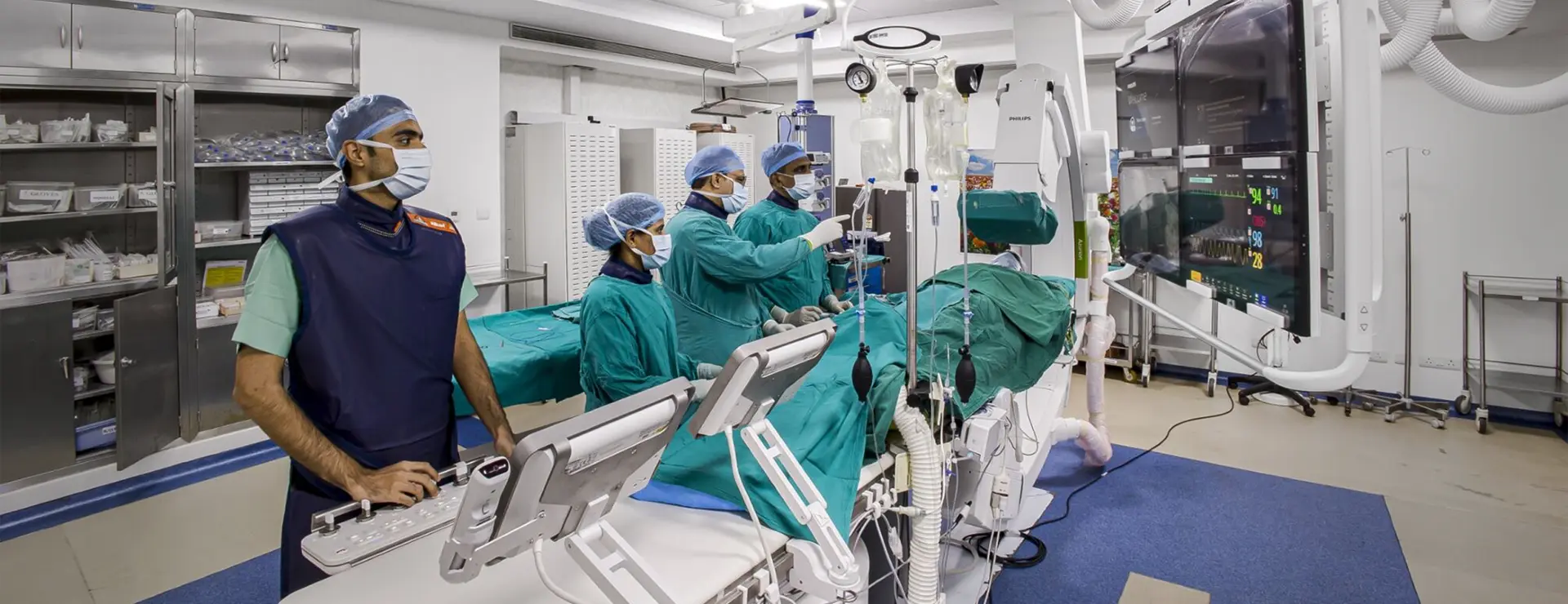Evidence-Based Approach for choosing Angioplasty
We choose Angioplasties that are appropriate and indicated and prioritise patient well-being by avoiding unnecessary procedures. Complications occur in less than 1% of the time.
Advanced Facility with Updated Techniques
Cutting-edge techniques like Intravascular Ultrasound, Optical Coherence Tomography, and Rotational Atherectomy for precise evaluation and treatment of Coronary Blockages.
Comprehensive Care by Surgery Experts
Our world-class surgical background ensures efficient and effective management, providing a safety net for patients facing any rare complications that might need to be dealt with through surgery.
Coronary Angioplasty at AHI
Coronary Angioplasty is a minimally invasive procedure that involves inserting a catheter through a small incision in the groin or arm and threading it up to the heart. This means that the procedure involves less pain, a shorter recovery time, and a lower risk of complications compared to traditional Open-heart Surgery.
Coronary Angioplasty can restore blood flow to the heart by widening narrowed or blocked coronary arteries. During the procedure, a balloon-tipped catheter is inserted into the artery and inflated to compress the plaque buildup against the artery wall, allowing blood to flow more freely.
Coronary Angioplasty can improve symptoms of Coronary Artery Disease, such as chest pain or discomfort, shortness of breath, and fatigue. By increasing blood flow to the heart, patients may experience a significant improvement in their quality of life.
Image Gallery
How to Prepare for this Procedure
- All previous reports should be brought including blood reports.
- The patient needs to be admitted on the day of the procedure.
- Have a light breakfast in the morning before coming to the hospital for the procedure. Fasting is needed at least 3 hours before the procedure.
- All medicines should be taken, except the diabetic medicines which should be withheld on the day of the procedure.
- Once admitted blood tests are done.
- Preparation for the procedure is done.
Angioplasty is done in a Cathlab. Local anaesthesia is given in the groin or wrist area. Using X-ray imaging, a coronary guide catheter is placed at the coronary origin. A balloon catheter - a fine, hollow tube with an inflatable balloon at its tip - which is flexible, and is guided into the blocked artery over a fine guide-wire until it reaches the narrowed section. The balloon is then inflated to compress the fatty tissue against the wall of the artery. This is followed by coronary stenting (a small tube of stainless-steel mesh). A coronary stent is mounted over a balloon, and the stent is deployed at the block site by inflating the balloon at high pressure. The balloon is then deflated and removed, leaving the stent in place.
Minimal physical support will be required when the patient is bed-bound. A family member can provide the most needed emotional support during these times.
After the procedure is completed, the catheter is removed. Sometimes, there could be a small amount of bleeding at that site. Your doctor will take care of that. You will be required to stay in bed for a while after the procedure. Most people are required to stay in the hospital for 2 days post Angioplasty. In case of an emergency Angioplasty, you may have to stay in the hospital for longer. When home, check your area of insertion of the catheter (groin or wrist). It is normal to have some bruising. However, if it worsens, or there is redness or swelling, contact your doctor. Before you leave the hospital, you will be told what you can and cannot do when you get home. It is best to avoid heavy physical activities initially. Discuss with your doctor when you can get back to your job and resume strenuous physical activity. Don’t drive for a week after your Angioplasty. In case you have suffered a heart attack, it could take longer to recover.
Whether you require Angioplasty or not depends on the blockages. It also depends on the willingness of the patient. If the patient is willing, then it can be done at the same time, which turns out to be convenient for the patient.
In 2011, I thought it was the end of my active life. But after my Angioplasty, I started running marathons!

Harshad Sheth
Patient
Not sure how to get started?
We are here to help you. To start the process get in touch with our team to get your queries addressed. We get back to you soon to help to start your heart care journey with us.
Quick QueryOur Specialists
View All
Dr. Ramakanta Panda
Cardiac Surgeon, Founder & Chairman
We want to give patients the three most invaluable gifts of life - Hope, Healing and Happiness.
Know
Dr Tilak Suvarna
Cardiologist
At AHI, we never say no. It is our moral and ethical duty to do our best for patients.
Know
Dr. Asifa Shaikh
Assistant Medical Administrator
After every patient is healed, earning their trust is our highest reward and the most fulfilling.
Know

